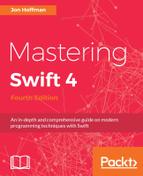As I mentioned at the start of this chapter, structures are value types and classes are reference types. What this means is that when we pass an instance of a structure within our application, such as a parameter of a method, we create a new instance of the structure in the memory. This new instance of the structure is only valid while the application is in the scope where the structure was created. Once the structure goes out of scope, the new instance of the structure is destroyed and the memory is released. This makes memory management of structures pretty easy and somewhat painless.
Classes, on the other hand, are reference types. This means that we allocate memory for the instance of the class only once, when it is initially created. When we pass an instance of the class within our application, either as a function argument or by assigning it to a variable, we really pass a reference to where the instance is stored in memory. Since the instance of a class may be referenced in multiple scopes (unlike a structure), it cannot be automatically destroyed, and memory is not released when it goes out of scope if it is referenced in another scope. Therefore, Swift needs some form of memory management to track and release the memory used by instances of classes when the class is no longer needed. Swift uses Automatic Reference Counting (ARC) to track and manage memory usage.
With ARC, for the most part, memory management in Swift simply works. ARC will automatically track the references to instances of classes, and when an instance is no longer needed (no references pointing to it), ARC will automatically destroy the instance and release the memory. There are a few instances where ARC requires additional information about relationships to properly manage the memory. Before we look at the instances where ARC needs help, let's look at how ARC works.
